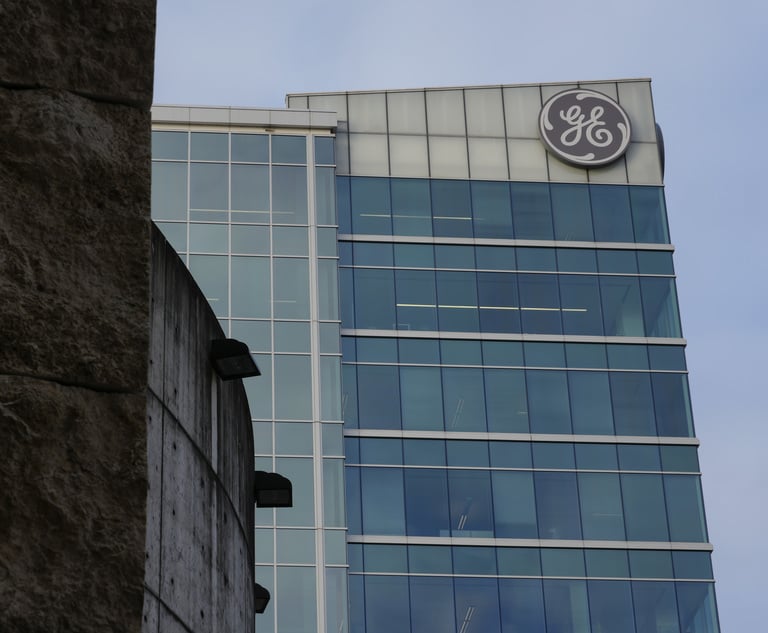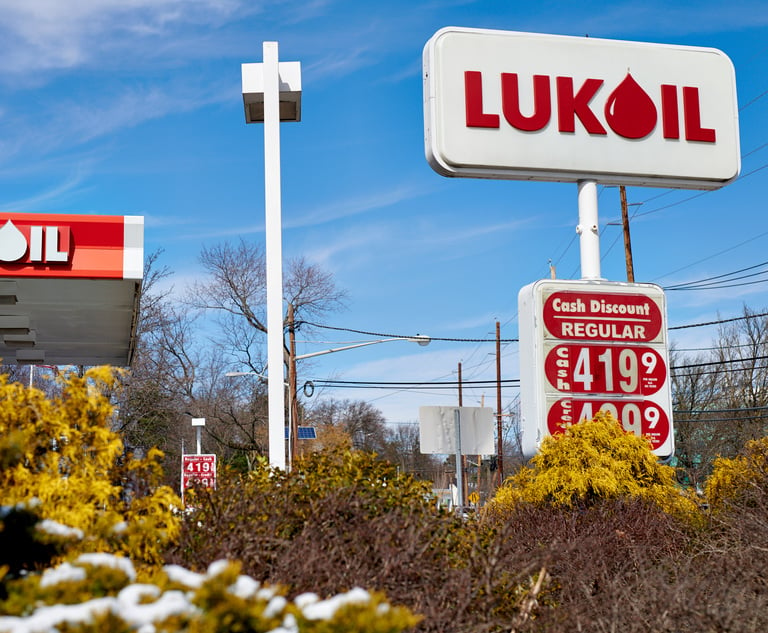EXCO Bankruptcy Illustrates Power of Chapter 11 Restructuring
In a world where quick Chapter 11 cases that fail to fully utilize the tools available under the bankruptcy code have become the norm, the EXCO cases serve as an example of the power of Chapter 11 to meaningfully restructure an oil and gas business and leave it positioned for go-forward success in a volatile commodities market.
November 06, 2019 at 11:45 AM
10 minute read
 On Friday, June 28th, 2019, EXCO Resources and its debtor affiliates (collectively, EXCO) emerged from bankruptcy having equitized over $1 billion of funded debt and shed significant litigation overhang and burdensome midstream contracts.
On Friday, June 28th, 2019, EXCO Resources and its debtor affiliates (collectively, EXCO) emerged from bankruptcy having equitized over $1 billion of funded debt and shed significant litigation overhang and burdensome midstream contracts.
EXCO's stay in bankruptcy lasted 18 months, with Judge Marvin Isugr of the U.S. Bankruptcy Court for the Southern District Texas presiding. The case included a full marketing process, two disclosure statement hearings, multiple proposed plans, a derivative standing fight, a multi-day confirmation trial, several rounds of mediation, and dozens of adversary proceedings and contested matters. EXCO's Chapter 11 cases were costly and contentious, with a half-dozen key players actively engaged in negotiation and litigation and dozens more protecting and advancing their interests. But in the end, EXCO confirmed a plan that had the support of every key constituent.
In a world where quick Chapter 11 cases that fail to fully utilize the tools available under the bankruptcy code have become the norm, the EXCO cases serve as an example of the power of Chapter 11 to meaningfully restructure an oil and gas business and leave it positioned for go-forward success in a volatile commodities market.
EXCO's Prepetition Challenges and Responses. To fully understand EXCO's journey through the bankruptcy process, it is necessary to turn back the clock several years. Like many of its peers in the oil and gas industry, EXCO was experiencing significant challenges in the years following the collapse of the oil and gas markets. It had an over-levered balance sheet and burdensome midstream transportation "take or pay" agreements. In an effort to address these challenge, EXCO sought to cut costs, reposition its asset portfolio, and improve its operational performance. In addition, EXCO worked to de-lever, executing a series of refinancing transactions between 2015 and 2017.
Following the 2017 refinancing transaction, EXCO's capital structure was comprised of an approximately $150 million RBL facility, approximately $300 million of "1.5 Lien" notes, an approximately $750 million "1.75 Lien" term loan facility, an approximately $20 million second lien term loan facility (a "stub" piece of debt from the 2015 refinancing), and approximately $200 million of unsecured notes. Importantly, over two-thirds of the 1.5 Lien notes were held by funds controlled by two entities (known as "Bluescape" and "Fairfax"), who also held a majority of the 1.75 Lien term loan, had representatives on EXCO's prepetition Board of directors (including during the 2017 refinancing transaction), and held significant equity positions. The dynamic between Fairfax and Bluescape and other creditor constituents was a key factor throughout the case.
In April 2017, EXCO executed an agreement to divest a significant portion of its assets. This would have materially improved its liquidity position and allowed EXCO to pay down a portion of its funded indebtedness and fund ongoing asset development. However, the transaction was terminated in August 2017 when one of EXCO's contract counterparties terminated a natural gas sales contract, leaving EXCO unable to satisfy a material condition to closing of the sale.
Accordingly, EXCO began engaging with its major creditor constituencies in the fall of 2017 regarding the terms of a potential consensual restructuring transaction. After lengthy negotiations between certain of the Company's secured lenders and an ad hoc group of unsecured noteholders, EXCO filed for Chapter 11 in January 2018 with a $250 million debtor-in-possession financing facility led by Bluescape and Fairfax.
EXCO's Bankruptcy and the Committee's Investigation. After commencing its Chapter 11 cases, EXCO launched a comprehensive marketing process. EXCO also engaged in negotiations with its secured creditors and the official committee of unsecured creditors (the Committee). The Committee, following a months'-long investigation, alleged two dozen causes of action against, among other parties, Bluescape and Fairfax, as well as certain of EXCO's current and former directors. The Committee focused on claims arising from the 2017 refinancing transactions, which were implemented by a Board on which the creditors served and resulted in a capital structure dominated by them, including fraudulent conveyance and preference theory claims. In the Committee's view, the claims could unlock hundreds of millions of dollars of value for unsecured creditors. If successful, such claims could result in the 1.5 Lien claims and 1.75 Lien claims becoming unsecured or subordinated to bond and other unsecured claims, materially transforming the capital structure. On the other hand, Bluescape and Fairfax did not view the claims as having material value, believing that their 1.5 Lien and 1.75 Lien claims were insulated from challenge on a variety of theories. EXCO worked to bridge this gap through multiple formal and informal negotiations. However, given Bluescape and Fairfax's position in the 1.5 Lien and 1.75 Lien claims, which gave them the ability to block a plan, EXCO had limited ability to propose a plan that would receive sufficient creditor support to be confirmed.
This dynamic left EXCO with effectively two choices: (1) litigate the estate claims to a final resolution during the bankruptcy proceeding, to determine the priority of the various claims; or (2) reach a consensual resolution of the causes of action among sufficient parties to support a confirmable plan. After several months of negotiations among EXCO and its creditor constituencies, EXCO sought the appointment of Chief Judge David R. Jones as a mediator. Judge Jones ultimately presided over approximately ten days of formal mediation, as well as numerous informal mediation sessions, telephone conferences, and correspondence with all parties. The mediation process provided an opportunity for parties to present their legal positions before an esteemed arbiter outside the confines of the courtroom, and the strength of the mediation privilege in Texas allowed for transparent and fulsome dialogue between the mediation parties. EXCO and its creditors negotiated vigorously, realizing that expansive litigation would likely have caused significant business disruption, but would be required if a deal could not be reached.
The First Plan and the Raider Creditors. In the fall of 2018, EXCO agreed on the terms of a consensual restructuring solution with the majority of its secured lenders and the Committee, which was documented in a plan filed in October 2018 (the First Plan). The First Plan embodied a compromise of multiple estate causes of action. The 1.5 Lien lenders would receive payment in full in cash (from the proceeds of a new financing facility), the 1.75 Lien lenders would receive 82% of the equity in the reorganized company, and the unsecured creditors (including the second lien creditors, unsecured noteholders, and general unsecured creditors) would receive, collectively, 18% of the reorganized equity. EXCO's insurance carriers also agreed to fund a cash settlement amount, all of which was allocated to unsecured creditors' recovery.
The First Plan also addressed significant claims asserted by contract counterparties at Raider. As part of its liability management strategy, EXCO had executed a divisional merger under Texas state law in April 2016, pursuant to which it created a new marketing entity (known as Raider). The divisional merger transferred to Raider, by operation of law, certain agreements for natural gas sales, marketing, gathering, and transportation, and associated liabilities. Raider separately managed the EXCO's marketing activities, allowing it to independently pursue various marketing opportunities. At the commencement of the case, EXCO had rejected several of the large contracts that had been assumed by Raider. Damages asserted by these creditors could have increased the size of the unsecured claims pool by hundreds of millions of dollars, significantly diluting any potential recovery to unsecured bondholders and other general unsecured creditors. Accordingly, resolution of these claims was another key factor in any plan.
The First Plan did not provide any recovery for unsecured Raider creditors due to the lack of unencumbered value at that entity available after satisfaction of 1.5 Lien, 1.75 Lien, and second lien claims. Multiple Raider creditors vigorously opposed the First Plan, challenging the 2016 divisional merger transaction. Various Raider creditors also challenged EXCO's rejection of their contracts or asserted counterclaims against EXCO seeking material damages. EXCO faced a similar choice with regard to claims asserted by Raider creditors, many of whom had complex and multi-faceted relationships with the company: engage in extensive and fact-intensive litigation, or attempt to reach a consensual resolution. With the continued assistance of Judge Jones, EXCO engaged in discussions and mediations with several of the significant Raider creditors in the lead up to a December confirmation hearing.
Volatility in the Capital Markets and the Amended Plan. Unfortunately, volatility in the commodities markets at the end of 2018 prevented EXCO from securing the exit financing necessary to implement the First Plan, and EXCO determined that a further de‑leveraging would be necessary to best position the company for continued success. After several more months of mediation and negotiations in early 2019, EXCO reached a revised deal with Bluescape, Fairfax, and the Committee that provided for the full equitization of all prepetition indebtedness—an improved outcome for the company's go-forward health, as the First Plan would have levered the reorganized EXCO with a $350 million exit RBL and approximately $350 million of second lien debt.
Pursuant to the revised compromise plan, 1.5 Lien noteholders would receive approximately 61% of the reorganized equity and 1.75 Lien lenders would receive approximately 39% of the reorganized equity, subject to reallocation based on the causes of action alleged by the Committee, which were preserved for litigation following the effective date. Non-settling 1.5 Lien and 1.75 Lien lenders would not receive a distribution on the effective date, but rather only upon resolution of any causes of action against them. In exchange for a release of estate claims and causes of action against Bluescape and Fairfax, they agreed to forgo approximately $60 million of value to which they would be entitled as holders of 1.5 Lien notes claims, which was made available to unsecured creditors. (The proceeds from the D&O settlement were retained by EXCO.)
This compromise was embodied in the Third Amended Plan, which was filed in April 2019. The two largest secured creditors other than Fairfax and Bluescape opposed Third Amended Plan on various grounds, including the preservation of causes of action for litigation post-effective date and the allocation of the Fairfax/Bluescape settlement proceedings. EXCO ultimately reached an agreement with both creditors—one before confirmation and the other after a two-day contested confirmation hearing. Ultimately, the plan was supported by all major creditor constituencies, all objections were consensually resolved, and the Third Amended Plan was confirmed by Judge Isgur on June 18, 2019.
Key Takeaways
EXCO's bankruptcy case was protracted and challenging, involving dozens of complex substantive and procedural issues. All parties involved hoped for a swift and painless resolution, and at various points throughout the case every constituency was frustrated by the pace and price of the process. Nonetheless, EXCO's challenging bankruptcy case ultimately had a silver lining. Due to the need to dramatically de-lever the capital structure after volatility in the financing markets at the end of 2018, and the ability to meaningfully address unprofitable business arrangements, EXCO emerged a dramatically de-levered and un-burdened entity with access to capital upon emergence. EXCO's bankruptcy provides an example of the powerful tools available to debtors‑in‑possession, and the results that can be achieved in Chapter 11. This will help EXCO weather, and hopefully thrive in, whatever tomorrow's oil and gas market holds.
Chris Greco, Alexandra Schwarzman and Patrick Nash are partners, and Ameneh Bordi is an associate, in restructuring group at Kirkland & Ellis.
This content has been archived. It is available through our partners, LexisNexis® and Bloomberg Law.
To view this content, please continue to their sites.
Not a Lexis Subscriber?
Subscribe Now
Not a Bloomberg Law Subscriber?
Subscribe Now
NOT FOR REPRINT
© 2025 ALM Global, LLC, All Rights Reserved. Request academic re-use from www.copyright.com. All other uses, submit a request to [email protected]. For more information visit Asset & Logo Licensing.
You Might Like
View All
Oil Co. Alleges Plot to Drive Away Competition in NYC's Liquid Fuel Market
3 minute read

GE Agrees to $362.5M Deal to End Shareholder Claims Over Power, Insurance Risks
2 minute read
Lukoil Pan Americas Sues Investment Firm Over Alleged $18 Million Breach
Trending Stories
Who Got The Work
J. Brugh Lower of Gibbons has entered an appearance for industrial equipment supplier Devco Corporation in a pending trademark infringement lawsuit. The suit, accusing the defendant of selling knock-off Graco products, was filed Dec. 18 in New Jersey District Court by Rivkin Radler on behalf of Graco Inc. and Graco Minnesota. The case, assigned to U.S. District Judge Zahid N. Quraishi, is 3:24-cv-11294, Graco Inc. et al v. Devco Corporation.
Who Got The Work
Rebecca Maller-Stein and Kent A. Yalowitz of Arnold & Porter Kaye Scholer have entered their appearances for Hanaco Venture Capital and its executives, Lior Prosor and David Frankel, in a pending securities lawsuit. The action, filed on Dec. 24 in New York Southern District Court by Zell, Aron & Co. on behalf of Goldeneye Advisors, accuses the defendants of negligently and fraudulently managing the plaintiff's $1 million investment. The case, assigned to U.S. District Judge Vernon S. Broderick, is 1:24-cv-09918, Goldeneye Advisors, LLC v. Hanaco Venture Capital, Ltd. et al.
Who Got The Work
Attorneys from A&O Shearman has stepped in as defense counsel for Toronto-Dominion Bank and other defendants in a pending securities class action. The suit, filed Dec. 11 in New York Southern District Court by Bleichmar Fonti & Auld, accuses the defendants of concealing the bank's 'pervasive' deficiencies in regards to its compliance with the Bank Secrecy Act and the quality of its anti-money laundering controls. The case, assigned to U.S. District Judge Arun Subramanian, is 1:24-cv-09445, Gonzalez v. The Toronto-Dominion Bank et al.
Who Got The Work
Crown Castle International, a Pennsylvania company providing shared communications infrastructure, has turned to Luke D. Wolf of Gordon Rees Scully Mansukhani to fend off a pending breach-of-contract lawsuit. The court action, filed Nov. 25 in Michigan Eastern District Court by Hooper Hathaway PC on behalf of The Town Residences LLC, accuses Crown Castle of failing to transfer approximately $30,000 in utility payments from T-Mobile in breach of a roof-top lease and assignment agreement. The case, assigned to U.S. District Judge Susan K. Declercq, is 2:24-cv-13131, The Town Residences LLC v. T-Mobile US, Inc. et al.
Who Got The Work
Wilfred P. Coronato and Daniel M. Schwartz of McCarter & English have stepped in as defense counsel to Electrolux Home Products Inc. in a pending product liability lawsuit. The court action, filed Nov. 26 in New York Eastern District Court by Poulos Lopiccolo PC and Nagel Rice LLP on behalf of David Stern, alleges that the defendant's refrigerators’ drawers and shelving repeatedly break and fall apart within months after purchase. The case, assigned to U.S. District Judge Joan M. Azrack, is 2:24-cv-08204, Stern v. Electrolux Home Products, Inc.
Featured Firms
Law Offices of Gary Martin Hays & Associates, P.C.
(470) 294-1674
Law Offices of Mark E. Salomone
(857) 444-6468
Smith & Hassler
(713) 739-1250






